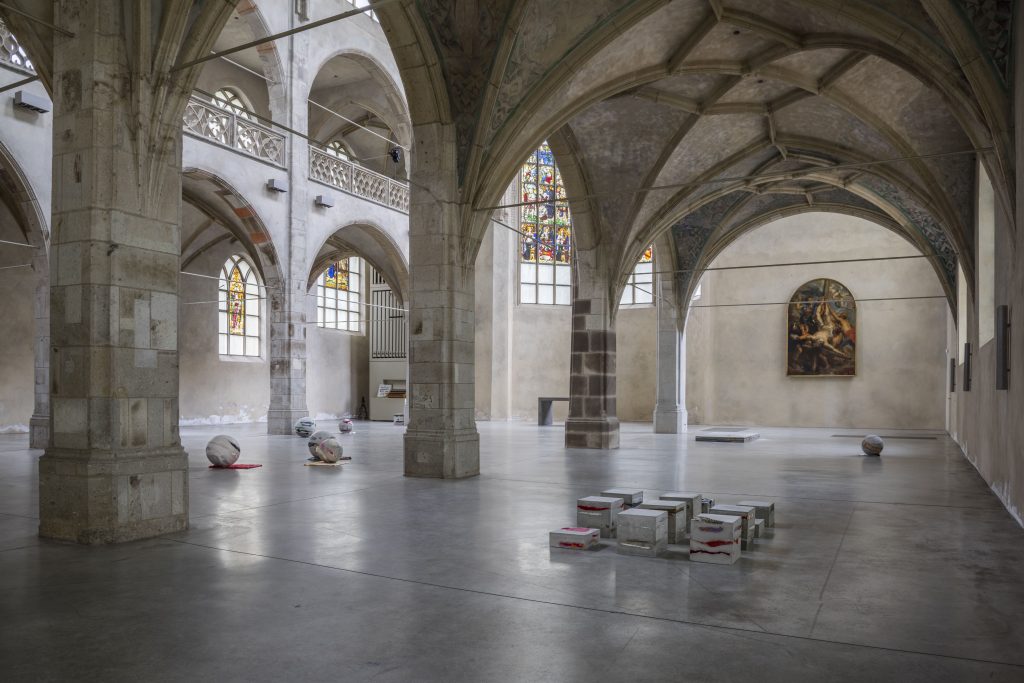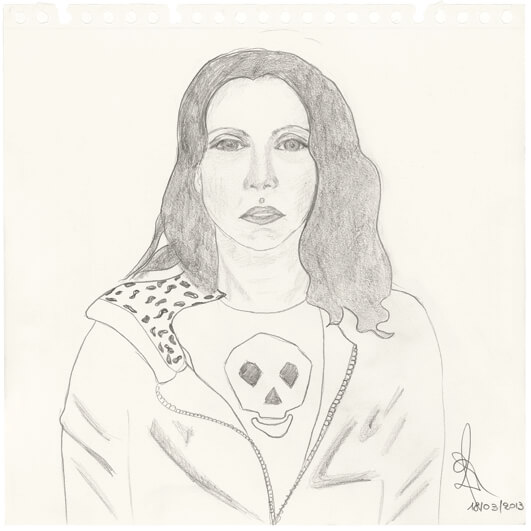Among the Olive Trees and Art: Rossella Biscotti

“I met contemporary art at the age of 23, but since I was a child I have always sought creative forms of expression, particularly in theater and cinema”.
With these words, Italian artist Rossella Biscotti (b. Molfetta, 1978) tells us about her beginnings in her homeland, Puglia and then in Napoli, where she studied and started her international artistic path. A path that in recent years has developed primarily in Asia and which, due to the COVID-19 lockdown, has forced her to return to her origins in Italy. Origins that she has never lost sight of: essential for artistic production, a place to which she dedicates some projects, including editorial ones.
The work of Biscotti is a combination of research, synthesis, and minimalism. It varies between mediums including performance, sculpture, installation, video and painting. It underlines the versatility of one who has traveled the world, between artist residences and the desire to discover new faces of reality.
Biscotti speaks exclusively interview to FRONTRUNNER from the land of olive trees – Molfetta in Bari – and the city that baptized her as an artist: Napoli.

A shirt, blue pants, blue jeans, a towel (2018)
22 sculptures, concrete and cloths
Installation view at Kunst-Station Sankt-Peter, Köln, 2018
Photo credit: Christopher Clem Franken
You are of Apulian origin, but you have centered your artistic training at the Accademia di Belle Arti di Napoli. Why did you choose this city?
I chose Napoli for its cultural life, language, historical and popular theatre. Before moving, I already knew the city quite well. In Napoli, I never felt like a stranger. From the beginning, the city has been part of my life and my education. At the same time, I knew I could contribute to the new artistic ferment: it was an exciting period, in the making.
At the Academy of Fine Arts in Napoli, I studied scenography and specialised in period costumes for the opera. I had a particular passion for avant-garde theatre, from Antonin Artaud to Eugène Ionesco, Samuel Beckett, Jean Genet, Erwin Piscator and Agitprop. Instead, I started seeing contemporary art through tours of historical galleries and friends, such as the Lia Rumma Gallery or the Supportico Lopez curatorial project. In those years, there was still no museum of contemporary art. I was immediately fascinated by the possibility of being able to create a story in a concise, conceptual way, through the precise elaboration of materials, space and time. I started producing my first videos in 2001, in Napoli.
What did Napoli leave you with? What do you miss?
I miss the city. I would go back to live there. Although after leaving Napoli I lived in many cities for short or long periods: Rotterdam, Berlin, Amsterdam, New York, Venice, Paris, Brussels, Istanbul, Rome, Singapore precisely. And I miss every place.
In general, how is a work by Rossella Biscotti conceived?
It comes from an observation, from a disjointed thought looking at an episode, from a personal story capable of activating a wider collective dimension. For example: the work Il Processo, which was exhibited in 2012 dOCUMENTA13 (Kassel), was conceived from my visit to the building that housed the former bunker hall of the Foro Italico in Rome, where the most important terrorist acts of the 1980s were carried out in Italy. I was there out of interest in the modernist architecture, designed by Luigi Moretti in 1938. But the impact of being in that classroom that I had seen several times on television and that had determined part of Italian political history led to investigate a specific process (the ‘7 April Process’ of the Workers’ Autonomy movement, between 1979 and 1988) and building all the work from there.
One of the latest works is a series of rubberised portraits of female characters taken from the tetralogy of the Buru Quartet by the Indonesian author Pramoedya Ananta Toer. This is my first work of literary inspiration, however, completely elaborated in the matter and in its processing.

The Trial (2013)
Documentation of a 2-day performance at e-flux, New York with 12 simultaneous interpreters and typists, set with original keys and benches from the High security Courthouse in Rome Video, 10’
Photo credit: Ray Anastas
Courtesy the artist and e-flux
Due to the COVID-19 pandemic, how has your profession changed? How have you dealt with and are going through this period?
Many of the projects I was doing have been postponed, some exhibitions canceled or postponed. In fact, starting in early February, I was in Singapore for a residency at the NTU CCA and had plans to do a work on oil palm plantations in South Asia, as well as a solo exhibition at Art Basel Hong Kong. Unfortunately, both of them were canceled. But I got to do some research in the city of Singapore and Malaysia, which led me to develop other projects.
In April, when I returned to Europe, I resumed work on the performance ‘The Journey’ scheduled for May 2021 as an off-site of the Kunstenfestivaldesarts in Brussels. It is a ship that departing from Valletta, Malta, will sail for a couple of days in the central Mediterranean sea following the GPS points relating to history, archeology, following the invisible lines that define the limits of oil and gas licenses, requests for help from migrants, wrecks; generally invisible points either because they are man-made and abstract as borders, or because they are below sea level.
I am finishing the book The Trial (2010-2018), which contains the work I told you about which has developed over the years into a sculpture installation, an audio work and a series of performances. The book will be published in the spring by Nero Editions (Rome). Perhaps a book is the most suitable work for this period of isolation.
If you had to analyze the current Italian socio-political situation with a work, what would it be and why?
The Italian political situation seems very complex to me, especially in this moment of pandemic. I do not know. I consider work as politics itself to better analyze it, using all our visual, cognitive, intellectual and sociological abilities.

I dreamt that you changed into a cat…gatto, ha ha ha (2013)
Pencil drawing made by Roberta Baseggio, a prisoner from the Giudecca Female Prison (Venice)
40 x 40 cm
Courtesy of the artist and Mor Charpentier Gallery (Paris)
The prerogative of art today should be, more than ever, synonymous with sharing and collaboration. With hope. Do you find yourself in these words?
Sharing and hope are beautiful words and concepts that I have certainly referred to several times in previous works. What comes to mind is the work I dreamt that I changed into a cat… gatto… ha ha ha (2013), where I had set up work on sharing nocturnal dreams among the prisoners of the Giudecca Female prison in Venice. In Brussels, we founded a kind of life and work cooperative: ‘Copost’. It’s a very interesting project. But never as in this period, with the pandemic, have social and racial injustices emerged in an evident way. It clarified the differences from a geographical, health and social point of view.
Recently, in an online conversation with anthropologist Michael Taussig for the Comp(H)ost project at Castello di Rivoli, we reflected on the role or response of art in this moment defined as an “environmental and political meltdown”. He coined an interesting concept of “mythological warfare”, a response, a mythological war. In my opinion, I don’t need to be frightened by the idea of going “to war” through the images, the works we create. Basically we already are.
What are your future projects?
In addition to the show The Journey and the book The Trial (2010-2018), I started a job in Puglia, back home, right in the semi-closing period. It’s a long story speaking of the dying situation of the olive tree landscape, so typical of the region, due to a bacterium called Xylella fastidiosa.
I started collecting ashes from burnt trees, which I mix with clay to create large urn-like pottery, one per tree. It’s a systematic process that connects the vase to what was the original olive tree, through the ashes and the engraving of its geographical coordinates. In reality, when fired, the ashes disappear leaving imperfections and a void. I find it interesting that the remains of the tree turn into this void which makes the ceramic lighter. With other artists and activists we are trying to figure out how to link these votes to a local re-game project, so that they can partially finance the reforestation of the region. I’m interested in how the object can connect with its olive tree past and future as a forest.
Responses